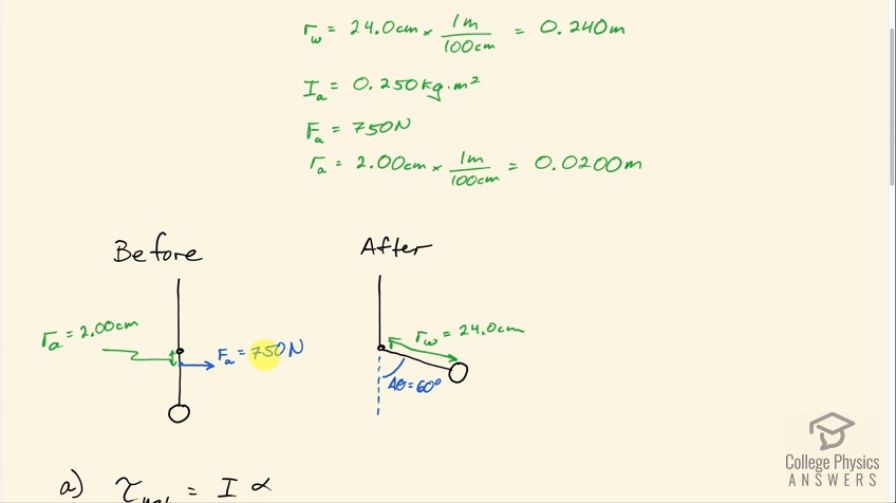Question
To develop muscle tone, a woman lifts a 2.00-kg weight held in her hand. She uses her biceps muscle to flex the lower arm through an angle of . (a) What is the angular acceleration if the weight is 24.0 cm from the elbow joint, her forearm has a moment of inertia of 0.250 kg ⋅ m2 , and the net force she exerts is 750 N at an effective perpendicular lever arm of 2.00 cm? (b) How much work does she do?
Final Answer
Solution video
OpenStax College Physics for AP® Courses, Chapter 10, Problem 30 (Problems & Exercises)

vote with a rating of
votes with an average rating of
.
Calculator Screenshots
Video Transcript
This is College Physics Answers with Shaun Dychko. A woman is going to lift a weight through an angle of 60 degrees, by applying a force of 750 newtons at a point on this forearm that's 2.00 centimeters away from this elbow joint so the lever arm for this muscle is 2.00 centimeters. We convert the 2.00 centimeters into meters and we also are given the moment of inertia of the arm—0.25 kilogram meter squared— the weight is 24.0 centimeters from the elbow and the weight has a mass of 2.00 kilograms. Okay! So the first part is to figure out what the angular acceleration of this weight is going to be so we know that net torque is going to equal moment of inertia mutliplied by angular acceleration so we can solve for α by dividing both sides by I and we get that α is τ net over I and the torque can be replaced with the force applied by the arm multiplied by its lever arm and these are perpendicular so we don't need to multiply by cosine here. Then we know that the moment of inertia of the arm will be... well, the moment of inertia of this whole system— arm and weight included— is going to be the moment of inertia of the arm plus the moment of inertia of the weight but the weight is a single-point mass and so we can use this formula: mass times distance from the pivot squared. So we replace I with all of this here and then plug in numbers so the angular acceleration then is 750 newtons times 0.0200 meters divided by 0.250 kilogram meters squared— moment of inertia of the arm alone— plus—moment of inertia of the weight— 2.00 kilograms times 0.240 meters— distance from the elbow—squared and that is 41.1 radians per second squared. The net work done is the net torque applied multiplied by the angular displacement. Now this isn't strictly true because this net torque changes as the mass moves up but I think what we are interested in here is the work done by the muscle and so that's what this is and the muscle is always applying 750 newtons of force so the torque applied by the muscle doesn't change. Okay! So we have the force applied by the muscle multiplied by its lever arm multiplied by the angular displacement converted into radians. So we multiply 60 degrees by π radians for every 180 degrees and the degrees cancel and so it's 60 times π divided by 180 and we end up with 15.7 joules of work done by the muscle.
